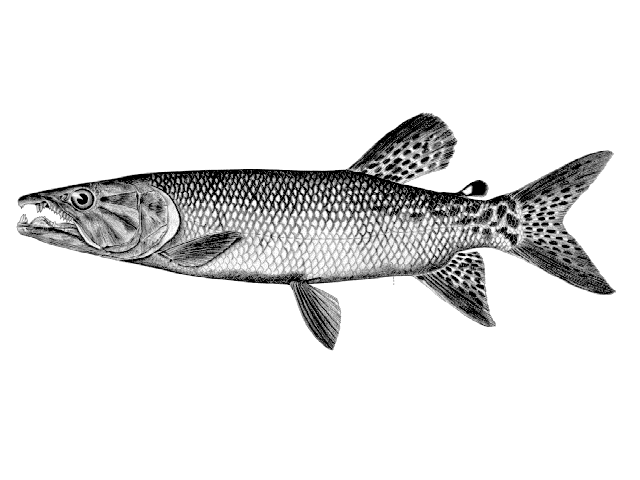| Hepsetidae (African pikes) |
| 37 cm SL (male/unsexed); max. reported age: 5 years |
|
demersal; freshwater, |
| Africa: Quanza, Cunene, Okavango, upper Zambezi and Kafue River systems; in the Congo River basin present in the southernmost part of the Kasai basin and in the lower Luapula River (Ref. 93907). |
|
Dorsal spines (total): 0-0; Dorsal soft rays (total): 9-9; Anal spines: 0-0; Anal soft rays: 12-12. Diagnosis: Hepsetus cuvieri can be distinguished from Hepsetus odoe based on a lower total number of gill rakers on the first gill arch, being 8–13 versus 14–21; a generally higher number of scales between the dorsal fin and the lateral line, 10.5–11.5 versus 7.5–10.5; a typically higher number of scales between the adipose fin and the lateral line, 6.5–7.5 versus 4.5–6.5; and a unique colour pattern characterized by a mottled appearance of the dark brown blotches on the lateral surface of the body versus the presence of vertical brown stripes/bars in that region in Hepsetus odoe (Ref. 93907).
Description: Head narrow and deep; snout pointed, narrow and short (Ref. 93907). Body form elongate with dorsal and anal fins set well back; laterally compressed, body torpedo-shaped (Ref. 93907). It has 6.5-7.5 scales between adipose fin and lateral line; 15-19 predorsal scales; 16-22 scales between dorsal fin and adipose fin; 12-18 scales between adipose fin and caudal fin (Ref. 88135, 93907). Dorsal fin with 2 unbranched and 7 branched rays; anal fin with 3 unbranched and 9 branched rays (Ref. 11970).
Colouration: overall body of preserved specimens color marbled light to darker brown dorsal surface; dark or lightbrown dorsal surface with mottled dark brown blotches, not always very obvious in preserved specimens, on flanks and cream coloured ventrally (Ref. 93907). Fins grey or blackish, generally translucent distally and sometimes transparent; caudal fin translucent, sometimes transparent in mid-centre and central part of upper and lower lobes; dorsal, anal and caudal fin with some small, rounded, dark-brown spots on membranes in-between rays and on rays themselves; spots more obvious in larger individuals, larger than about 145 mm standard length; adipose fin cream basally, distally black (Ref. 93907). Three well-marked, dark-brownish bands radiate behind eye on infra-orbitals and terminate on opercle; small black dorsoventrally elongated spot present behind head above lateral line; series of 10-16 small greyish elongated vertical bands, first situated just behind opercle and last situated just anterior to caudal-fin base sometimes present, these bands tentatively identified as stress bands (Ref. 93907). Body colour in life or freshly caught specimens marbled brassy olive to darker brown; dorsal surface dark brassy olive with mottled dark brown blotches on flanks and cream coloured ventrum; adipose fin orange basally, remainder part black (based on Skelton et al. 1985; Skelton 2001) (Ref. 93907). |
| Prefers quiet, deep water, like channels and lagoons of large floodplains; juveniles and fry inhabit well-vegetated marginal habitats (Ref. 7248). Adults feed on fish, juveniles feed on small invertebrates and fish (Ref. 7248). Multiple spawner; breeds over the summer months; relatively short-lived, only 4-5 years; also caught with drawnets (Ref. 7248). |
|
Least Concern (LC); Date assessed: 28 July 2019 Ref. (130435)
|
| harmless |
Source and more info: www.fishbase.org. For personal, classroom, and other internal use only. Not for publication.

